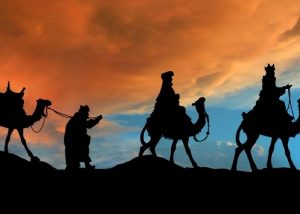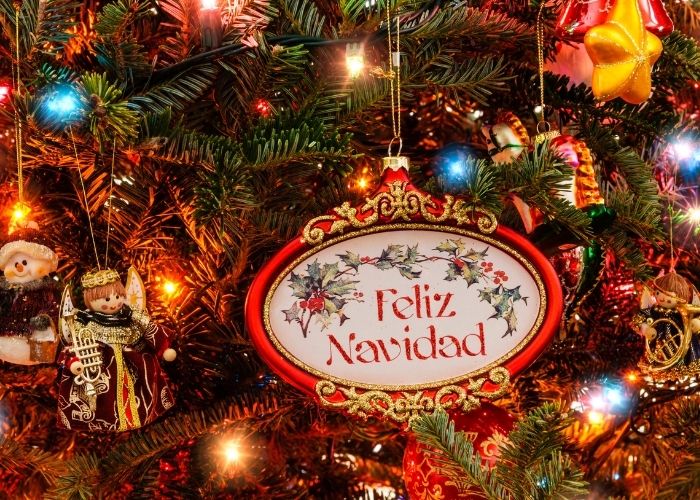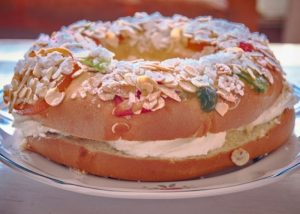December 8th marks the beginning of the religious festive celebrations in Spain. It is a public holiday as it is The Day of the Immaculate Conception (Dia de la Inmaculada Concepción). This is a significant day in many parts of the world as it celebrates the Catholic belief of the Blessed Virgin Mary´s immaculate conception and is considered the first official day of Christmas (Navidad).
From today on until January 6, there is much to prepare and celebrate. And many festive celebrations and traditions to follow. These are not just for the children, but for all the family to enjoy.
#InSpain.news lists some here. Some you will know, but others are a little more unusual or unique to certain parts of Spain.
Hogueras de Navidad (Festive bonfires)
For some Andalucian towns, there is a tradition of celebrating the holiday period with giant bonfires. This usually takes place a few days before Christmas on the winter solstice, December 21. Do be careful if you try this. However, jumping over the flames is supposed to bring health, happiness, and luck for the coming year. But I imagine if you misjudge this jump, it will be bad luck!
If your luck was in jumping over the bonfire, let´s hope you have bought a ticket to play El Gordo as the special Christmas Lottery starts the following morning.
El Gordo (“the Fat One”)
The Spanish love the lottery, but especially at this time of the year, you may see queues even larger than usual. This is one of the most exciting traditions in Spain as almost everyone buys a ticket. There are massive prizes to be won this year worth over a total of €2.52 billion.
El Gordo has taken place each year since 1812. Nowadays, the winning numbers are announced live on television on the morning of December 22. This is more than just announcing numbers. A boy or a girl from the S Ildefonso school extracts a ball from the number drum and at the same time another child draws from the prize drum. As the numbers and prizes are called, they are sung out by two other school children. Something not to be missed.
But before the draw is carried out…
On December 21, the examination and counting of the balls with the numbers and prizes that will be used on the day of the draw is carried out in public, at night, at 11.00 pm.
Once the checking and counting is finished, the room is evacuated, and all its accesses are secured with interior bolts. It is only possible to enter through the door of the dais, whose only keys remain in the possession of the “claveros” (in charge of security).
Thus, nobody is prevented from entering until the day of the draw.
On the morning of December 22, the hall always opens at 8.00 am. This is to allow the spectators to enter, with no other limitation than the capacity of the venue. It is very common for there to be long lines waiting to enter.
Midnight Mass
Midnight Mass is attended in lots of countries around the world, but with over half of the Spanish population being Catholic, it is a very important event. Mostly Midnight Mass takes place on Christmas Eve. This is known as La Misa Del Gallo (The Mass of the Rooster). This is because when Jesus was born, seemingly a rooster was crowing. Christmas Eve (Nochebuena) is also a time when many families sit down together to eat their main Christmas meal just before attending Midnight Mass. It is when families give thanks and celebrate the birth of Jesus Christ.
St Stephen´s Day (Boxing Day)
This is not normally celebrated as a “day” in Spain, however, in Catalonia, they do. Here they have an interesting tradition as in years gone by, when Catalan families gathered for Christmas Day, due to the bad weather, often they could not return home. So, in true Spanish style, it was the perfect excuse to extend the Christmas Day festive celebrations and include December 26 too!
Dia de los Santos Inocentes
The Day of the Innocents takes place on December 28. Beware, you may be on the receiving end of a prank. This day is like our Aprils Fool´s Day. You can dress up in funny wigs or hats, and you can play fun practical jokes on people. When you do this, you are meant to shout “inocente, inocente!”. Also very common on this day, is for someone to stick a drawing on your back.
 Portal de Beléns
Portal de Beléns
This is the stable of Bethlehem. All over Spain, there are some amazing nativity scenes you can visit. Great care and detail go into these scenes. Not only will they be in official buildings for you to see, but also many shops and households open their doors for you to visit their creations. Town halls have awards and recognition for the efforts of their inhabitants. In a previous article, we wrote about one of the largest nativity scenes in the world.
An unusual addition to these nativity scenes is the pooping man (caganer).
The pooping log (Caga Tió)
More about pooping! This is one of the most curious traditions common in Catalonia. Caga Tió, meaning pooping log, is basically a wooden log dressed up with a face, legs, blanket, and a barretina (Catalan hat) so it doesn´t get cold. The children “feed” the Caga Tió with small pieces of bread or orange peel every evening in the lead-up to Christmas. The log is kept in the house or the garden.
Then, on Christmas Eve at night or on Christmas morning, they sing the Caga Tió song and hit the log with a stick. They ask him to poop out Turrón and other sweets for them. When they finish the song, they remove the blanket and find all the hidden sweets.
New Year´s Eve (or Hogmanay as it is known in Scotland)
Preparation and technique are the key factors to counting down the clock towards midnight in Spain. You must have twelve grapes at the ready and a glass of champagne. As the clock begins to strike, a grape must be eaten and a sip from the champaign. If you manage to eat all 12 grapes on each chime, you will have good luck for the following year. Editor´s tip – seedless grapes are easier! This is actually one of the more difficult festive celebrations to accomplish!
El Arrastre
This is a tradition in Cádiz on January 5. The children string together empty cans on a piece of rope and drag them around the streets. The aim is to make as much noise as possible so that the Three Kings won´t forget to leave their gifts. As legend has it, the noise is also used to scare a mythical giant who tries to cover the sky with smoke to prevent the Three Kings from delivering gifts to the children.
The Three Kings
Traditionally Christmas is not celebrated in Spain as we would know it in the UK. There is no Santa Claus. Although over time, and with many nationalities living in Spain, it is always a good excuse to celebrate both days. In fact, Spanish children often receive a small gift on December 25.

On the evening of January 5, towns and cities are filled with families from all generations lining the streets. They are waiting for the Parade of the Three Kings (Cabalgatas). This is another event not to be missed. The atmosphere is fantastic, and the children are so excited. As the floats pass, they throw sweets to the children. If you intend to go, don´t forget to take a bag. Although many children are so inventive, they hold an umbrella upside down to catch as many as possible.
There are long queues outside the bakeries as people wait to buy their Roscón de Reyes.
When they return home, the children leave their shoes outside at the door. When the Three Kings visit during the night, they fill the shoes with gifts for the children to open in the morning.
El Apalpador
However, in Galicia, they have a slightly different, more unusual version of the tradition. El Apalpador is a mythical giant coal miner who feels the children´s stomachs to see if they have been eating well. He then leaves behind little treats such as chestnuts and sweets.
Olentzero
In the Basque country, a mythical giant called Olentzero is their version. He is a rugged, peasant version of Santa who smokes a pipe. He brings gifts for the children in return for food and alcohol. The giant visits the children on December 24. (Sounds similar in part, to Scotland!!!).
 Roscón de Reyes
Roscón de Reyes
This traditional cake can be bought in all supermarkets at this time of the year, or, as mentioned above, you can find the queues outside the bakeries during the parade of the Three Kings. The cake is a festive celebration of the arrival of the Three Kings in Bethlehem. Hidden inside the cake is a broad bean and a crown or small figurine. The person who finds the figurine can wear a crown (paper hat) and will be blessed with good luck for the rest of the year. However, traditionally, the person who finds the bean must pay for the cake next year.
As well as Turrón and Roscón de Reyes, there are many other foods and sweets the Spanish enjoy over the festive period. Look out for our next article in our festive series to find out more.

 Portal de Beléns
Portal de Beléns

 Roscón de Reyes
Roscón de Reyes